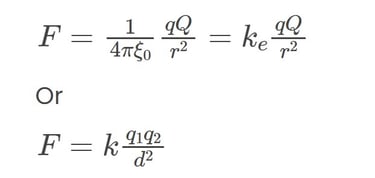Electrostatics


Electrostatics is a fascinating branch of physics that delves into the behavior and properties of stationary or slow-moving electric charges. In this article, we will embark on a journey to explore the intricacies of electrostatics, from understanding Coulomb’s Law to unraveling the concept of electric fields.
Table of Contents
What is Electrostatics?
Coulomb’s Law of Electrostatics
Electric Field
Positively Charged Particles
Negatively Charged Particles
Neutral Particles
Electrostatics Examples
Electrostatics Questions
Electrostatics Worksheet PDF Download
Electrostatics Suggested Videos
Frequently Asked Questions – FAQs
Electrostatics, as mentioned, is a branch of physics that focuses on the behavior of electric charges at rest or in slow motion. These charges, whether positive or negative, possess inherent properties that lead to intriguing phenomena and interactions. Despite the seemingly weak nature of electrostatic forces, they play a crucial role in shaping our understanding of the physical world.
What is Electrostatics?
Coulomb’s Law of Electrostatics
At the heart of electrostatics lies Coulomb’s law, which quantifies the force between electric charges. This law states that the force between two point charges is directly proportional to the product of their magnitudes and inversely proportional to the square of the distance between them.


Join Best Learning Program....






Understanding Electric Fields
Electric fields are pivotal in electrostatics, representing the influence that a charge exerts on its surroundings. They provide a framework for understanding the forces experienced by charged particles in a given region. The concept of an electric field enables precise calculations and predictions in electrostatic scenarios.
Behavior of Positively Charged Particles
Positively charged particles, such as protons, exhibit specific behaviors within electrostatic fields. They tend to move towards regions of lower electric potential, experiencing forces directed opposite to the field lines. Understanding their behavior is crucial in various applications, including particle accelerators and plasma physics.
Behavior of Negatively Charged Particles
Negatively charged particles, like electrons, behave differently within electrostatic fields compared to their positively charged counterparts. They move towards regions of higher electric potential, aligning with the direction of the electric field lines. This behavior plays a pivotal role in electronic devices and semiconductor physics.
Electrostatics with Neutral Particles
Even neutral particles can be influenced by electrostatic phenomena under certain conditions. Induced charges and polarization effects can arise when neutral objects interact with charged bodies or fields. Understanding these interactions is essential in areas such as material science and atmospheric physics.
Examples on Electrostatics
Rubbing a balloon on hair to make it stick to a wall.
Lightning during a thunderstorm .
Dust collection in electrostatic precipitators .
Ink spraying from an inkjet printer .
Hair standing on end when rubbed with a balloon.
Frequently Asked Questions – FAQs
Q1: What is electrostatics?
Electrostatics is a branch of physics dedicated to studying stationary electric charges.
Q2: How does electrostatics work?
Electrostatic phenomena emerge from the forces exerted by electric charges on each other, as outlined by Coulomb’s law. Despite appearing weak, these forces govern various interactions.
Q3: Why is electrostatic force conservative?
The electrostatic force exhibits conservatism as the work done on a charge remains constant regardless of the path taken.
Q4: What are examples of electrostatics?
Examples include the attraction of plastic wrap to your hand post-package removal and the adherence of paper to a charged scale.
Q5: Why is electrostatic force considered a central force?
The electrostatic force earns the label "central force" because it operates along the line connecting two charges, defining its direction and magnitude.
